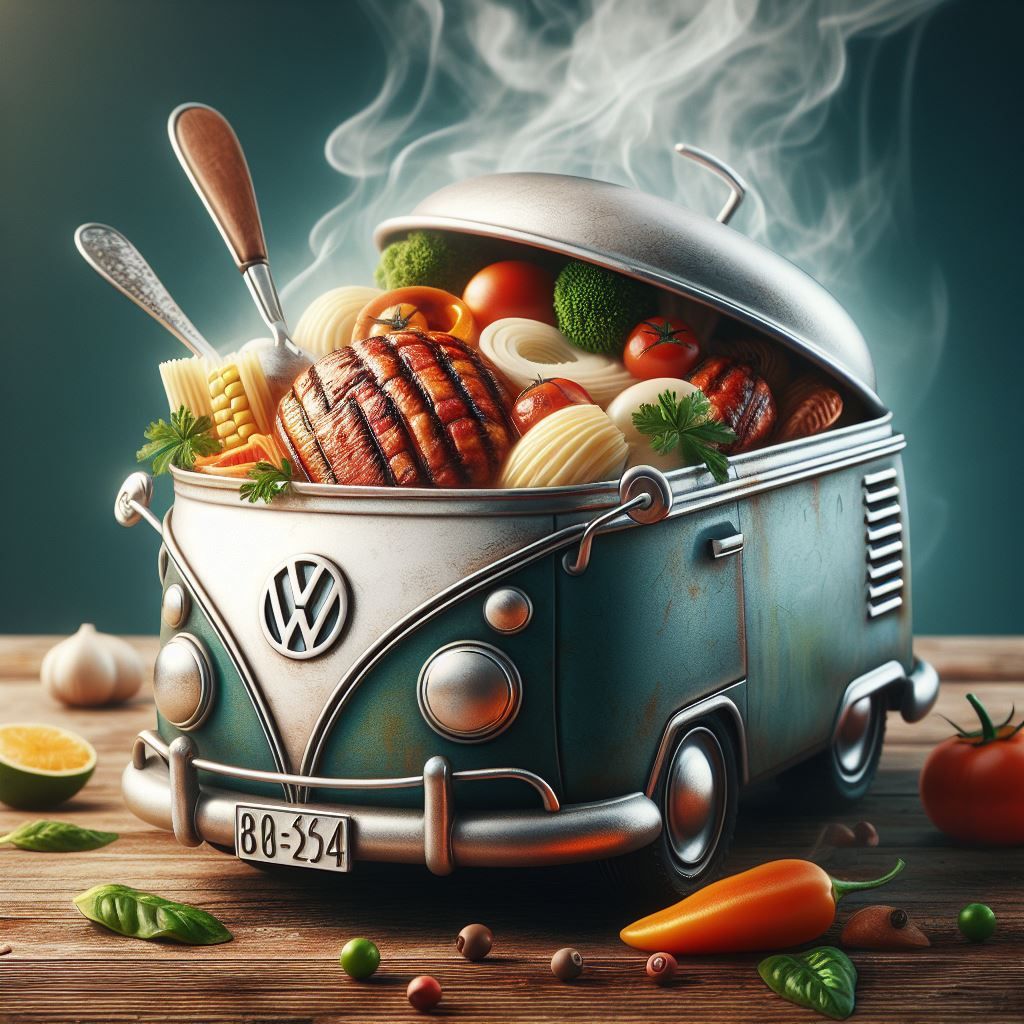Dreaming of a kitchen upgrade that wows? Imagine an inspired wood epoxy kitchen island stealing the spotlight in your home. Picture this: a unique blend of nature’s beauty and modern design, creating a focal point that sparks conversations and admiration. Can you envision the warmth of wood merging seamlessly with the captivating allure of epoxy to elevate your space? With endless possibilities for customization, this stunning piece not only adds functionality but also infuses character into your kitchen. Get ready to transform your cooking area into a haven where style meets functionality effortlessly.

Key Takeaways
- Incorporate natural elements: Enhance the beauty of your epoxy kitchen island by incorporating natural elements like wood, stones, or shells for a unique and personalized touch.
- Ensure proper ventilation: Prioritize safety by following ventilation requirements when working with epoxy resin to protect yourself from harmful fumes.
- Plan your design carefully: Invest time in design planning and layout to create a cohesive and visually appealing wood and epoxy kitchen island that fits your space and style.
- Use high-quality materials: Opt for essential materials and tools of good quality to ensure the durability and longevity of your kitchen island, maintaining its aesthetic appeal over time.
- Experiment with metallic pigments: Explore creativity by experimenting with metallic pigments to add a touch of luxury and sophistication to your wood and epoxy design.
- Protect and maintain your island: Implement proper finishing techniques, such as sanding and sealing, to protect your kitchen island from wear and tear, ensuring its longevity and preserving its aesthetic appeal.
The Fusion of Nature and Modern Design
Organic Harmony
Wood epoxy kitchen islands effortlessly combine the natural allure of wood with contemporary design, resulting in a stunning focal point in any modern kitchen. These islands serve as a perfect example of blending nature with sleek aesthetics, creating a unique piece that adds warmth and character to the space. The intricate details within the epoxy resin mimic tree rings or flowing rivers, bringing life into the heart of your home.
Wood epoxy designs are not just pieces of furniture; they represent an artistry that merges two worlds seamlessly. By mixing elements from nature with modern style, these islands become more than just functional additions but true works of art. Imagine having a beautiful wooden island with blue epoxy swirls resembling ocean waves, adding a touch of tranquility to your kitchen.
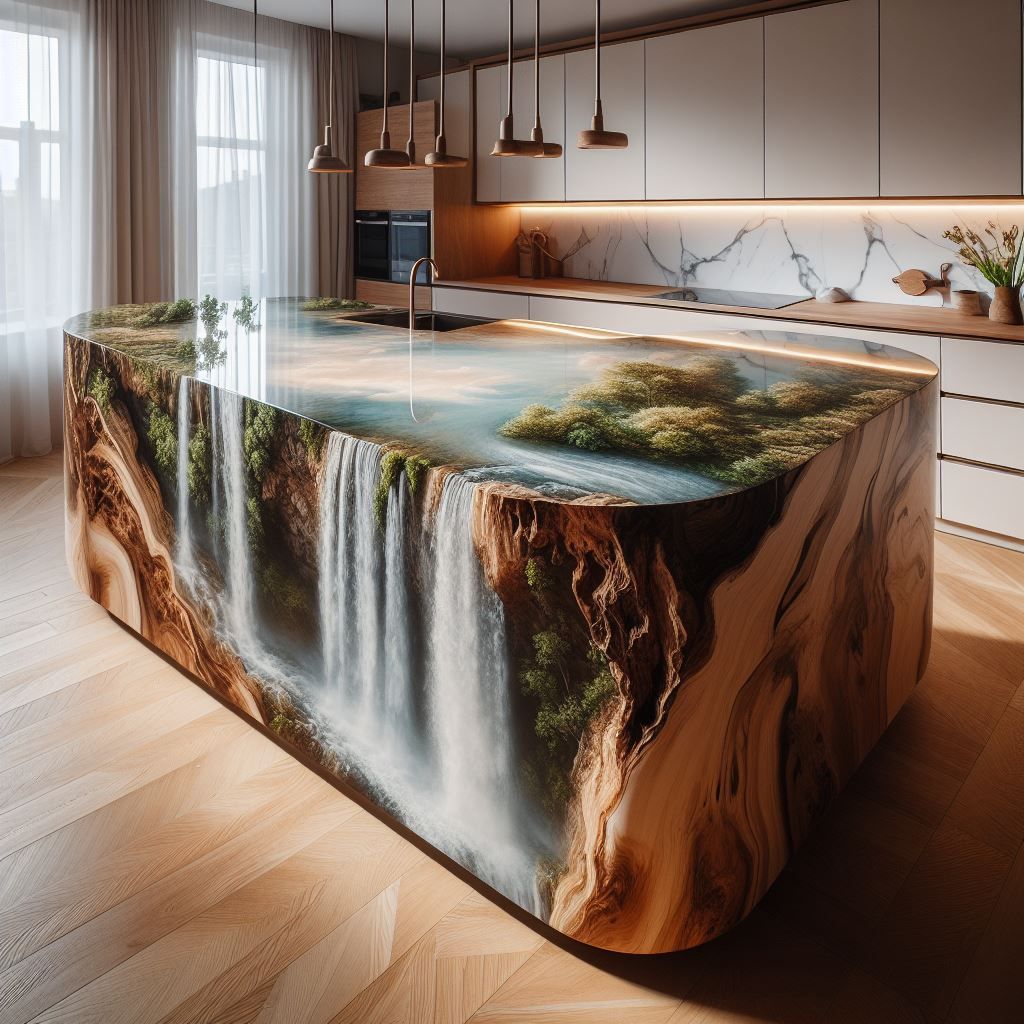
Warmth and Character
The beauty behind wood epoxy kitchen islands lies in their ability to infuse any room with love and charm. These creations are more than mere furniture; they embody a perfect blend between organic materials and contemporary design concepts. Picture walking into your kitchen every day greeted by this masterpiece – it’s like stepping into a world where nature meets innovation.
- Wood epoxy islands create an inviting atmosphere, making your kitchen feel cozy and welcoming.
- They provide an opportunity to showcase creativity through custom designs tailored to individual preferences.
- These pieces offer durability alongside aesthetic appeal, ensuring long-lasting beauty for years to come.
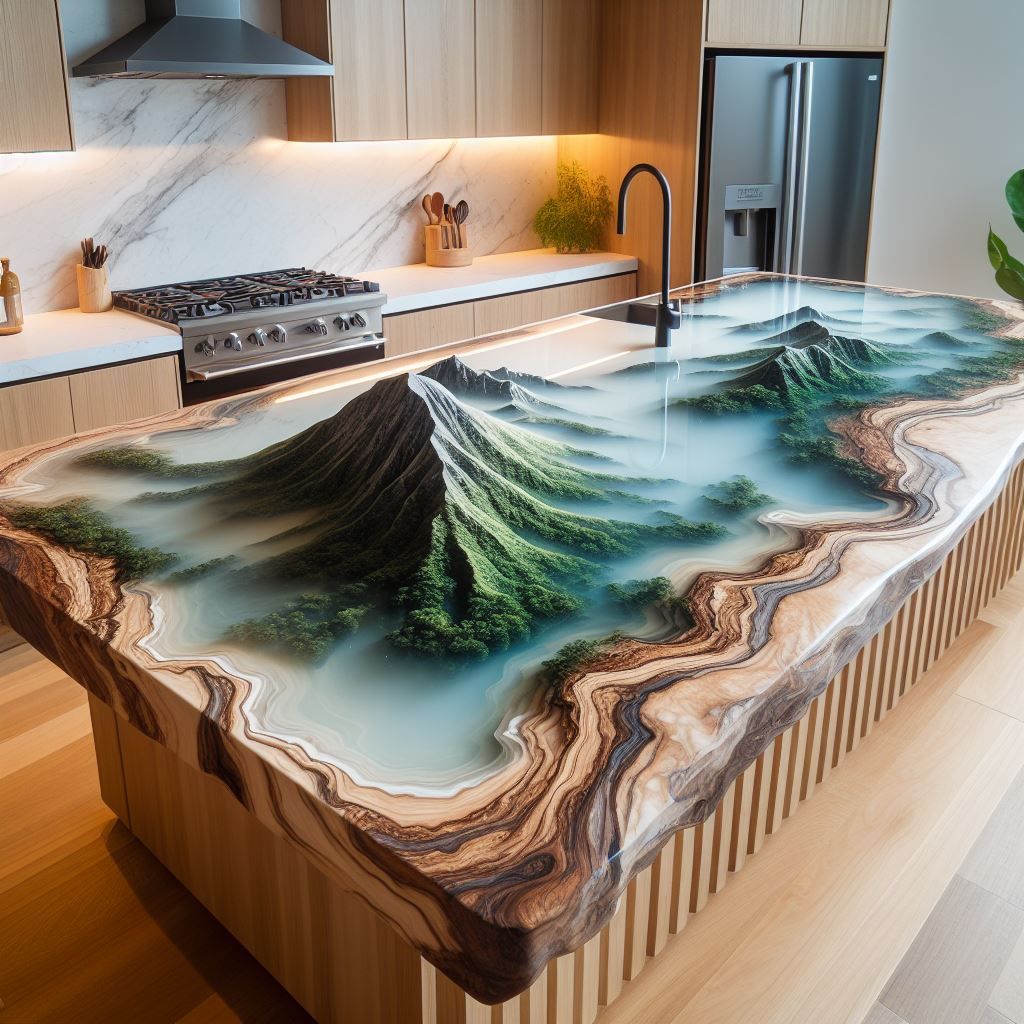
Essential Materials and Tools for Crafting
Key Materials
Crafting an inspired wood epoxy kitchen island requires specific materials to achieve a stunning outcome. The primary components needed are wood slabs, which form the base of the island, providing a natural and rustic appeal. epoxy resin is essential as it creates a durable and glossy finish on the wood surface. To add a touch of elegance and uniqueness, incorporating metallic pigments into the epoxy resin can result in mesmerizing swirls of color that enhance the overall aesthetic.
When selecting these materials, opt for high-quality options to ensure longevity and visual appeal. High-grade wood slabs will not only look more visually appealing but also offer greater durability over time. Similarly, investing in premium epoxy resin guarantees a smooth finish that withstands daily wear and tear while maintaining its luster.
- Pros:
- High-quality materials ensure durability
- Metallic pigments add unique design elements
- Cons:
- Costlier than lower-quality alternatives
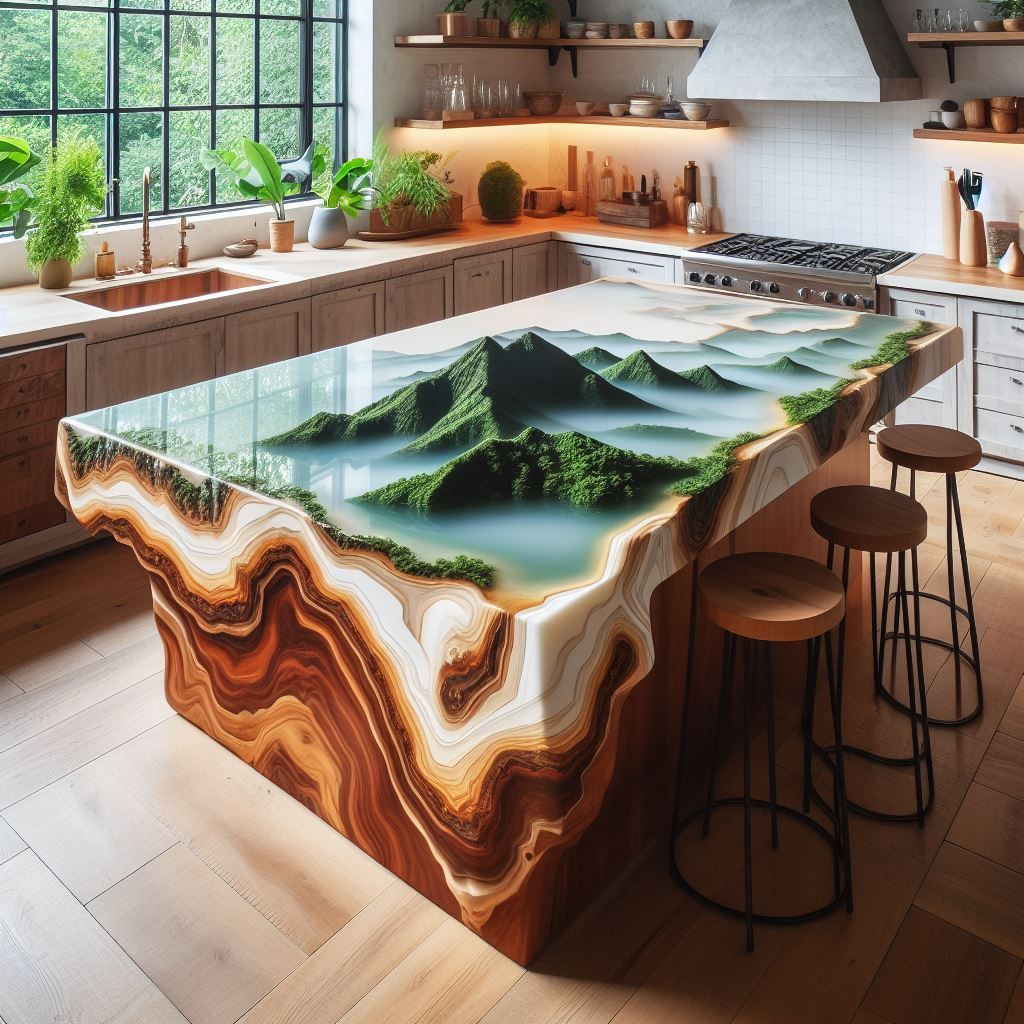
Essential Tools
Apart from materials, having the right tools is crucial when embarking on crafting an inspired wood epoxy kitchen island project. Some indispensable tools include a sander for smoothing out rough edges on both the wood slab and cured epoxy surface. A router is necessary for creating intricate designs or patterns on the wooden surface before applying epoxy.
Other essential items include mixing containers to blend epoxy resin with metallic pigments thoroughly. Lastly, a heat gun plays a vital role in removing air bubbles trapped within the epoxy mixture during curing, ensuring a flawless final result.
To streamline your crafting process and achieve professional-looking results, make sure you have all these tools readily available before starting your project.
- Sand down rough edges using sander.
- Use router to create desired patterns.
- Thoroughly mix resin with metallic pigments in dedicated containers.
- Eliminate air bubbles with heat gun during curing process.

Design Planning and Layout for Epoxy Islands
Careful Planning
When designing an inspired wood epoxy kitchen island, meticulous planning is essential. Factors like size, shape, and placement play a crucial role in achieving the desired outcome. It’s vital to think about how the island will fit into the existing kitchen layout.
Detailed sketches or design software can be incredibly useful tools during this phase. They allow you to visualize how the finished epoxy island will look in your kitchen space before any construction begins. This step helps ensure that your vision aligns with practical considerations.
- Visualize final look with sketches or software
- Ensure island fits seamlessly into existing layout
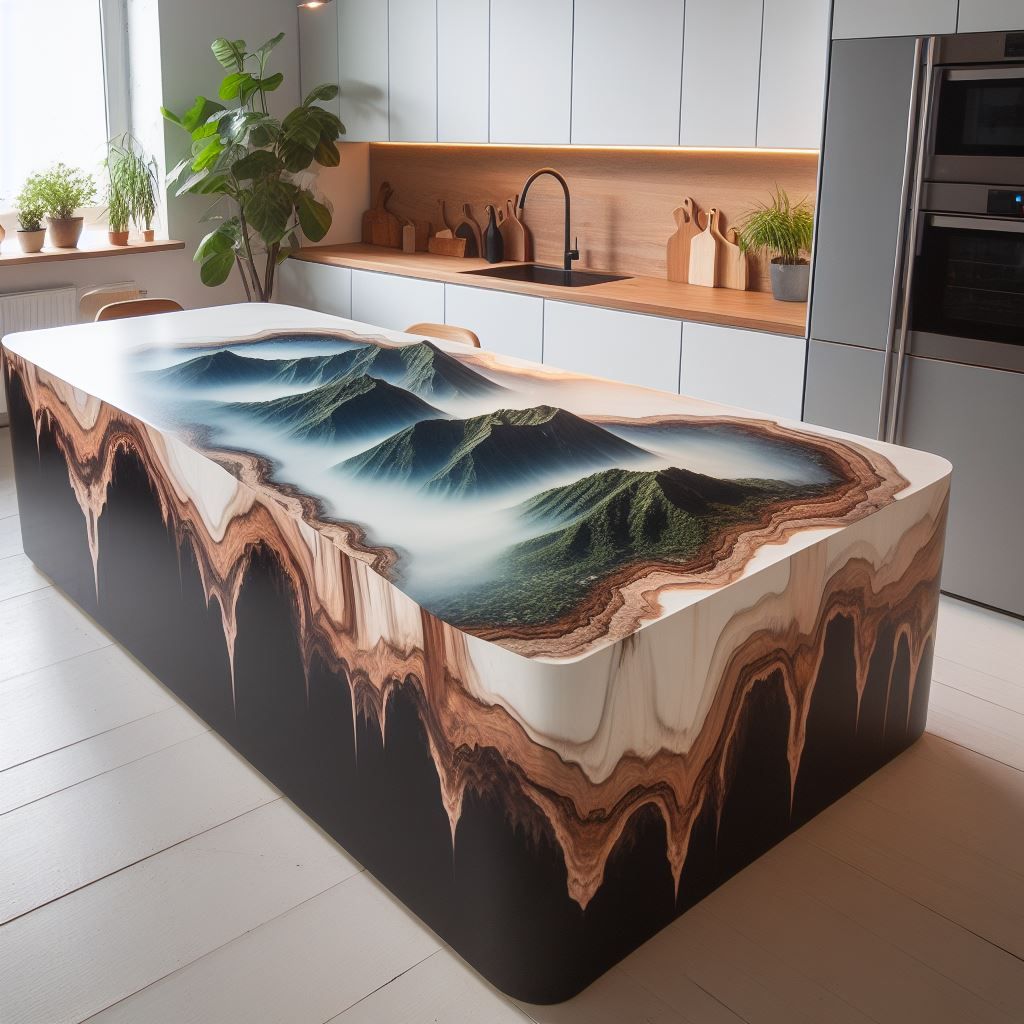
Considerations for Layout
During the design process of a wood epoxy kitchen island, several considerations need attention. The size of the island should complement the available space while allowing for comfortable movement around it. The shape of the island can also impact its functionality and aesthetics.
Placement is another critical aspect to ponder when creating an epoxy centerpiece for your kitchen. Optimal placement ensures easy access to appliances, adequate countertop space, and smooth workflow within your cooking area.
- Size should match available space
- Shape impacts both function and appearance
- Proper placement enhances usability
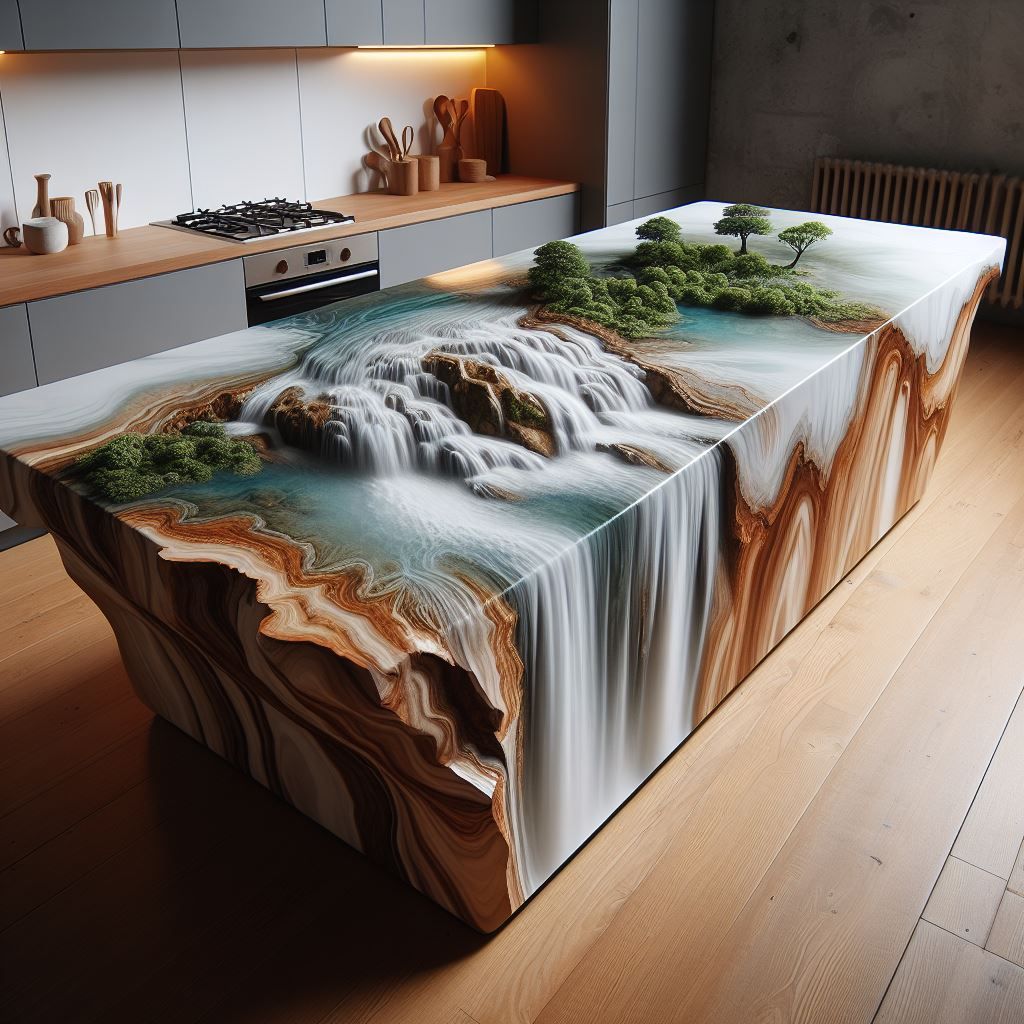
Incorporating Natural Elements and Metallic Pigments
Enhancing Organic Appeal
Natural elements like flowers, leaves, or seashells can be embedded in epoxy resin to enhance the island’s natural beauty. By incorporating these elements, the kitchen island gains a unique and organic appeal. Imagine a kitchen island with delicate flower petals preserved in clear epoxy, creating a stunning visual centerpiece.
Mixing natural elements with epoxy not only adds natural beauty but also provides a personal touch to the kitchen space. The combination of wood textures and colorful flowers encapsulated in resin brings nature indoors, making the kitchen island more than just a functional piece—it becomes an artistic expression.

Creating Visual Effects
Metallic pigments offer endless possibilities for adding depth and dimension to the epoxy surface. These pigments come in various shades like gold, silver, copper, or bronze that can transform the plain resin into a shimmering masterpiece. Picture a kitchen island with swirls of metallic blue pigments dancing across its surface under ambient lighting.
Experimenting with different combinations of natural elements and metallic pigments allows for unparalleled customization options. By blending seashells with iridescent pigments or mixing dried leaves with metallic flakes, each creation becomes one-of-a-kind. The interplay between light reflections on metallic surfaces and embedded natural materials creates an enchanting visual spectacle.
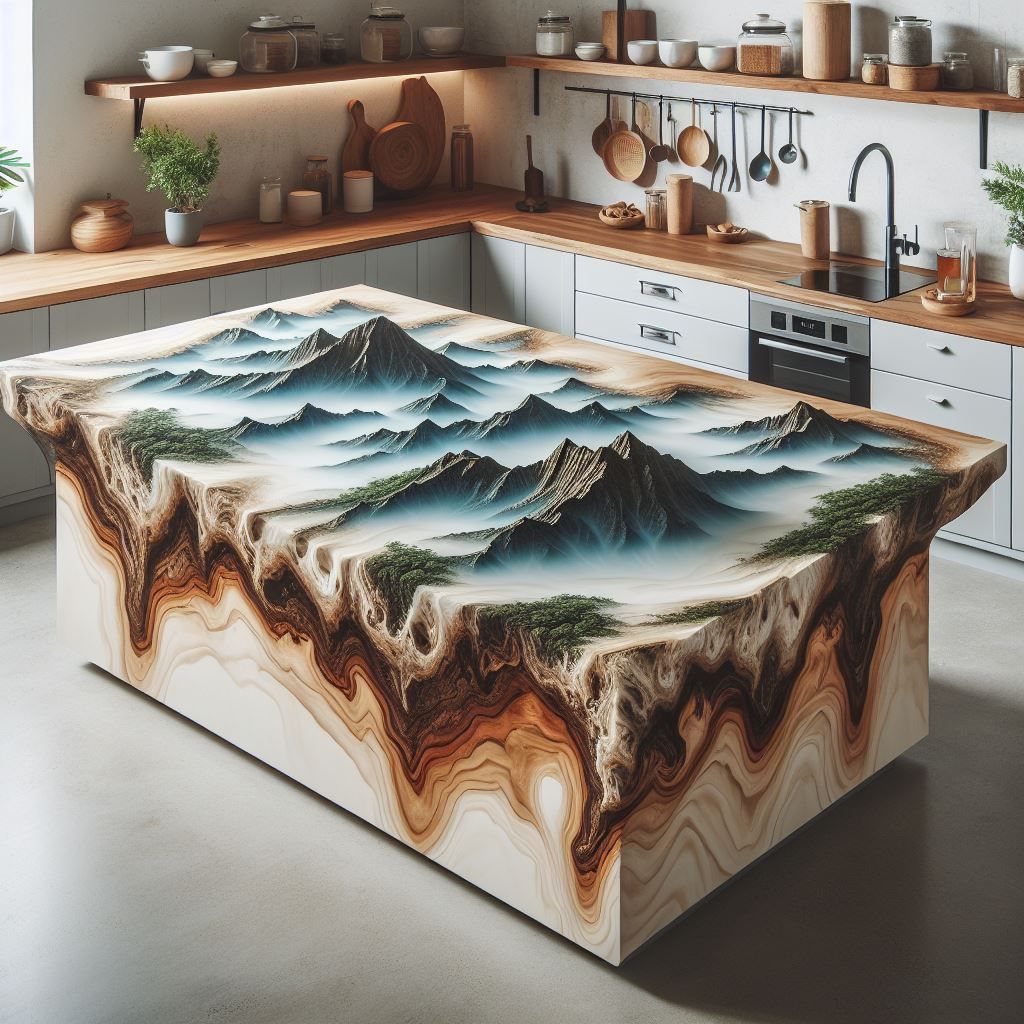
Constructing the Frame and Pouring Epoxy Resin
Sturdy Frame
Building a sturdy frame is crucial for supporting the weight of epoxy resin. A solid foundation ensures structural integrity, preventing any sagging or cracking over time. By using high-quality wood and precise measurements, you guarantee durability.
Crafting a frame that complements the design enhances the overall aesthetic appeal of the kitchen island. The frame’s shape can influence the final look, whether it’s a sleek modern design or a rustic farmhouse style.
Wood Surface Preparation
Before pouring epoxy resin, preparing the wooden surface is essential to achieve a flawless finish. Sanding down rough edges and sealing cracks prevent leaks during resin application.
Sealing imperfections on the wood surface not only ensures a smooth pour but also maintains the integrity of intricate designs. Proper preparation guarantees that each layer of epoxy adheres securely to create stunning patterns within the island.
Layered Epoxy Pour
Pouring epoxy resin in multiple layers allows for creativity with various colors and textures. Each layer adds depth to your design, creating unique patterns and visual interest within your kitchen island.
Layered pours provide an opportunity to experiment with different techniques such as incorporating metallic pigments or natural elements like stones or shells into your design. This method enables you to customize your island according to your preferences, adding personal touches that make it truly one-of-a-kind.

Safety Measures and Ventilation Requirements
Protective Gear
When working with epoxy resin for your inspired wood epoxy kitchen island, wearing protective gear like gloves and goggles is crucial. This equipment helps prevent skin irritation or eye damage that can be caused by direct contact with the resin. By using gloves, you shield your hands from potential chemical reactions.
It’s essential to wear safety goggles to protect your eyes from splashes of epoxy resin during the construction process. These simple precautions ensure that you can work comfortably without risking any harm to yourself. A respirator may be necessary when dealing with strong fumes emitted by certain types of epoxy resins.
Adequate Ventilation
Proper ventilation is key when working with epoxy resin due to the harmful fumes it releases during the curing process. Ensuring good airflow in your workspace prevents these fumes from accumulating and causing health issues. A well-ventilated area allows fresh air to circulate, reducing the concentration of airborne particles.
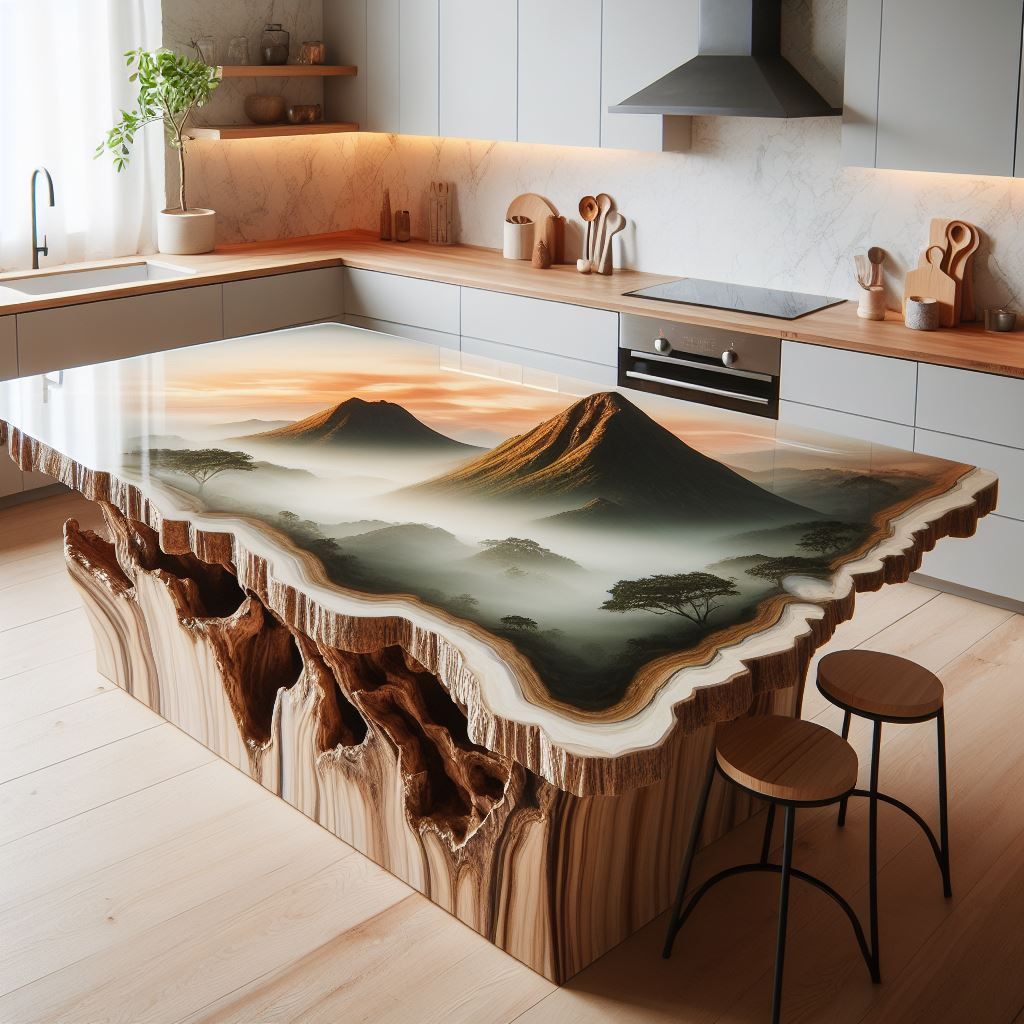
Sanding, Finishing Techniques, and Protection
Sanding
Sanding the cured wood epoxy kitchen island surface is crucial for achieving a smooth and polished finish. This process involves using sandpaper to remove any imperfections or rough spots on the epoxy surface. By sanding carefully and evenly, you can create a sleek and flawless appearance for your kitchen island.
To start sanding your woodworking project, begin with a lower grit sandpaper to eliminate any major bumps or uneven areas. Gradually progress to higher grits for a finer finish. Remember to use gentle pressure while sanding to avoid damaging the epoxy layer. After completing the sanding process, wipe down the surface with a damp cloth to remove any dust particles before proceeding with finishing techniques.
- Begin by using lower grit sandpaper
- Progress gradually to higher grits
- Apply gentle pressure when sanding
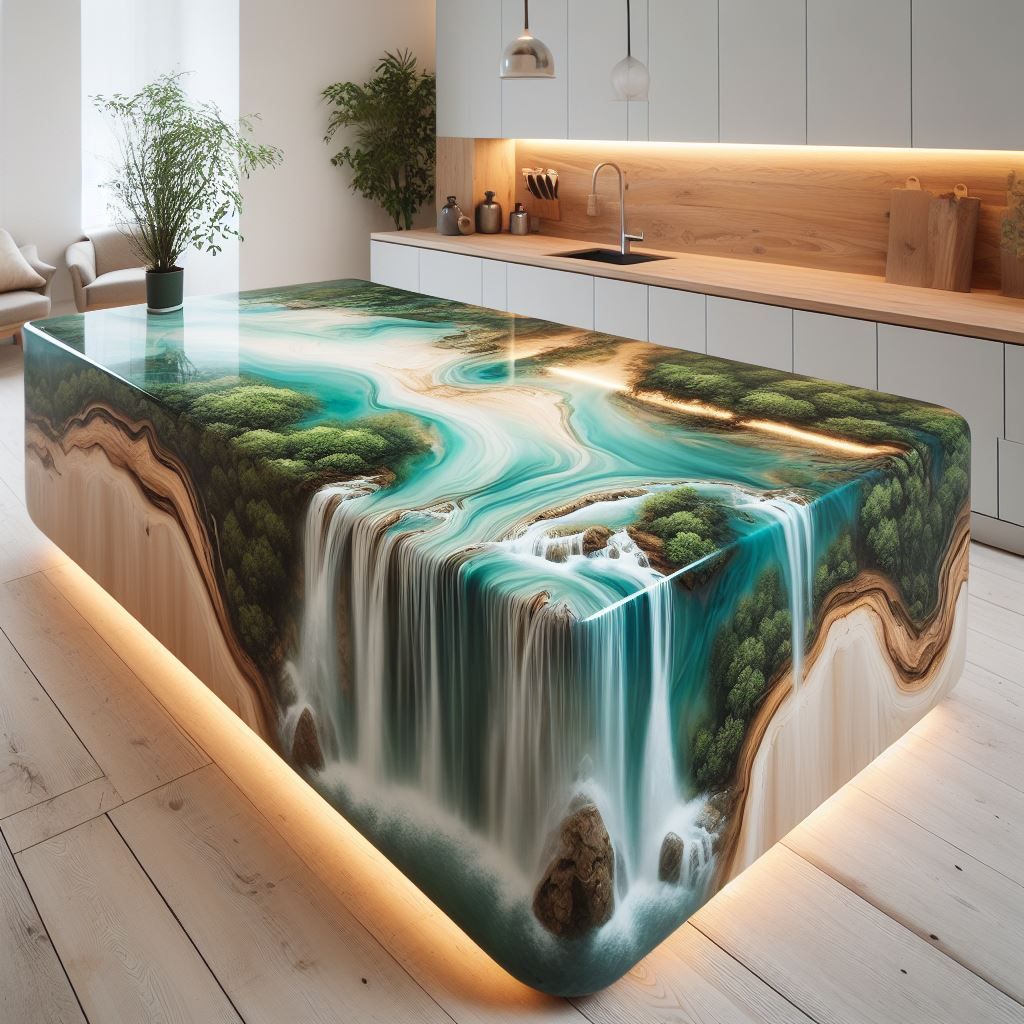
Finishing Techniques
Applying a clear topcoat or varnish is essential for protecting the inspired wood epoxy kitchen island from UV damage and enhancing its overall durability. The topcoat acts as a shield against sunlight exposure that can cause discoloration or deterioration of the epoxy over time. It provides an extra layer of protection against scratches and stains.
When selecting a topcoat or varnish for your project, opt for products specifically designed for use on epoxy surfaces. Follow the manufacturer’s instructions carefully during application to ensure optimal results. A well-applied topcoat not only safeguards your kitchen island but also adds depth and sheen to enhance its aesthetic appeal.
- Protects from UV damage
- Enhances durability of wood epoxy surface
- Adds depth and sheen
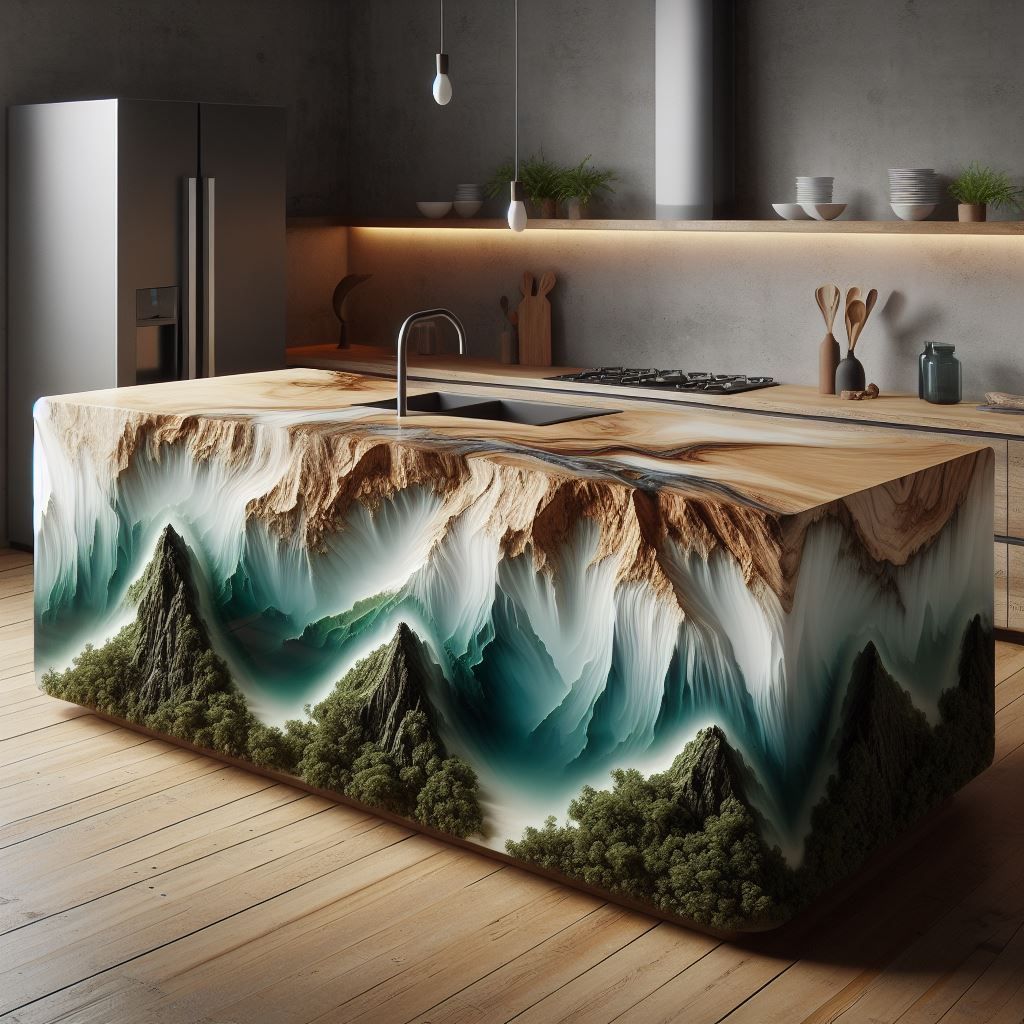
Protection
Regular maintenance practices are essential in preserving the beauty of your inspired wood epoxy kitchen island over time. Simple tasks such as cleaning with mild soap and water help prevent dirt buildup that can dull the surface’s shine. Avoid using harsh chemicals or abrasive cleaners that may damage both the wood and epoxy layers.
In addition to regular cleaning routines, consider applying furniture wax periodically as an additional protective measure against wear and tear. Wax helps maintain the luster of both wood and epoxy components while providing an extra barrier against moisture absorption.
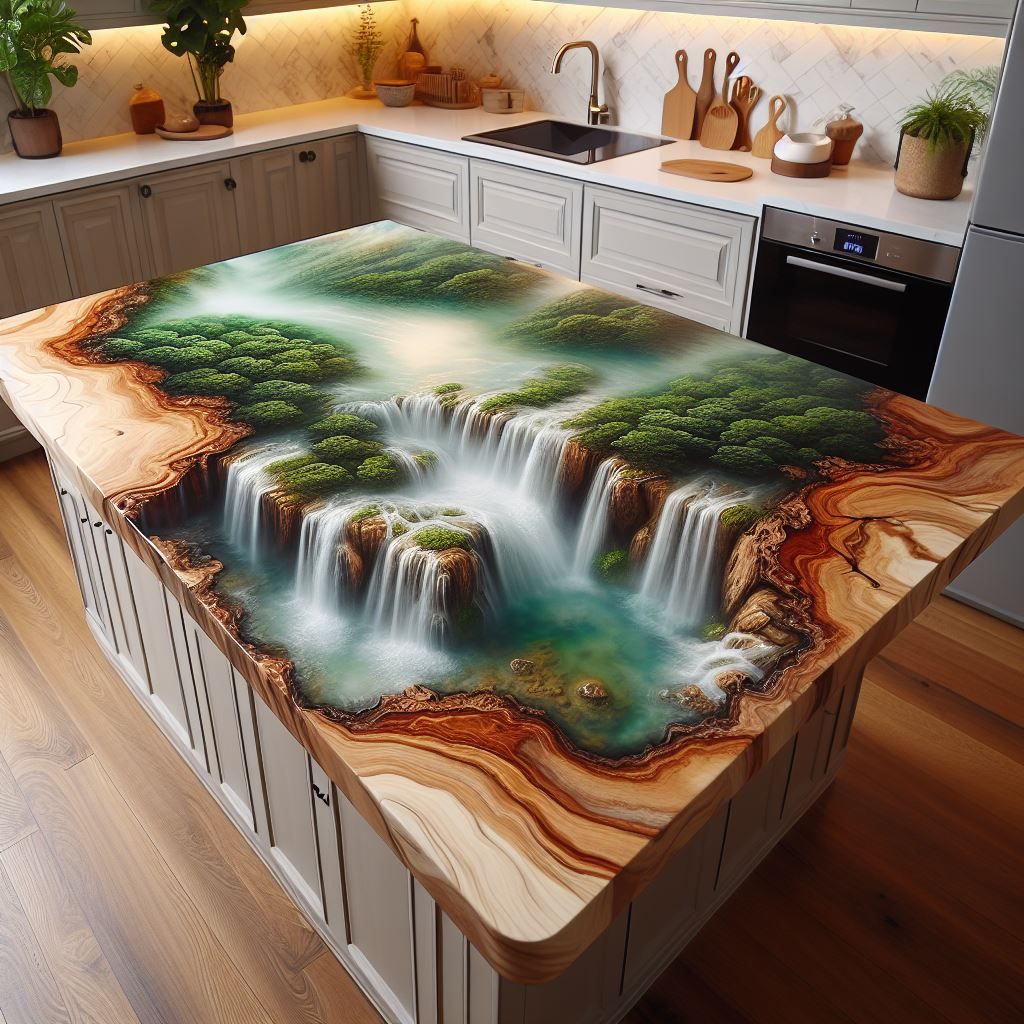
Durability, Longevity, and Aesthetic Appeal
Resistant to Wear and Tear
Wood epoxy kitchen islands boast durability against scratches, stains, and heat. The protective layer of epoxy resin shields the wood from daily wear and tear. This durability ensures that your kitchen island maintains its pristine condition for years.
The scratch-resistant quality of epoxy surfaces prevents unsightly marks from detracting from the island’s aesthetic appeal. Even with regular use in a bustling kitchen environment, these islands remain free from scratches or blemishes. Their ability to withstand heat also makes them ideal for cooking activities without worrying about damage.
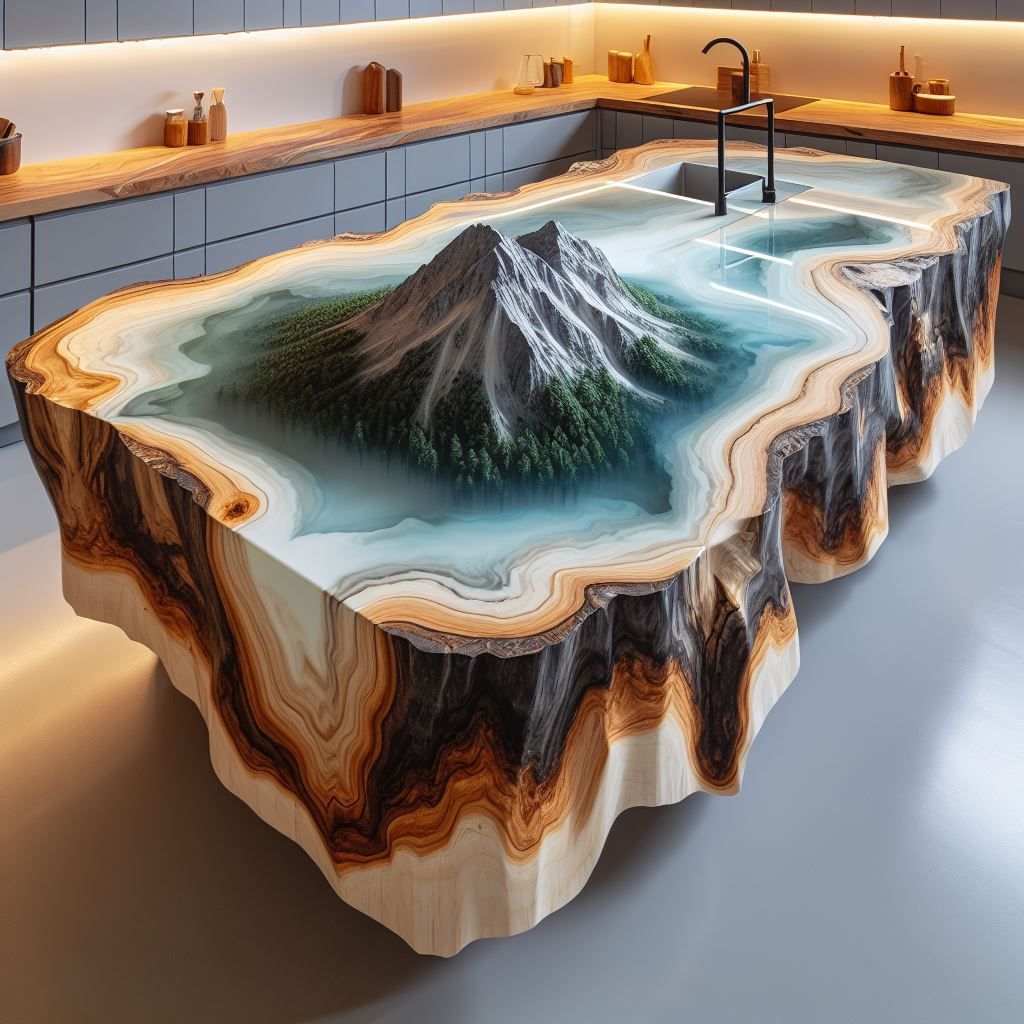
Unique Visual Impact
One of the most captivating features of wood epoxy kitchen islands is their uniqueness in design. The patterns and colors created by the epoxy resin are truly one-of-a-kind on each island. These distinctive designs make every piece visually stunning and add an artistic touch to any kitchen space.
The glossy finish achieved through the application of epoxy enhances the overall beauty of the wood, creating a luxurious look that elevates the entire kitchen area. With varying sizes available, you can choose an island that perfectly fits your space while still making a bold statement with its striking appearance.
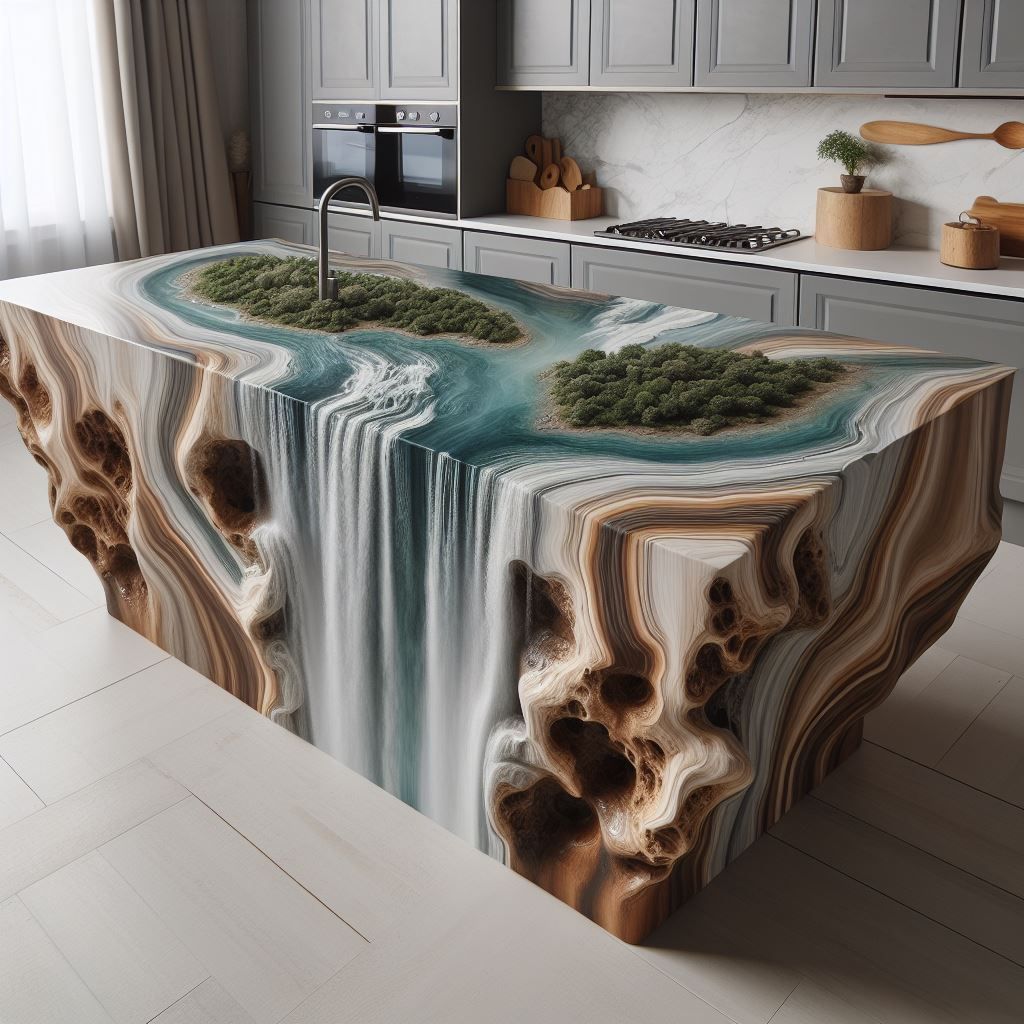
Unique Ideas for Wood and Epoxy Kitchen Islands
Rustic Charm with Live Edge Wood Slabs
Live edge wood slabs are a fantastic addition to an epoxy kitchen island design. They bring a natural, rustic charm that adds character to the overall look. These irregular edges give the island a unique and organic feel, blending beautifully with the sleekness of epoxy resin. Imagine a kitchen island where the live edge wood slabs seamlessly flow into glossy epoxy surfaces, creating a stunning contrast between raw nature and modern elegance.
Incorporating live edge wood slabs can transform your kitchen island into a focal point in your home. The combination of rugged wood textures with smooth, shiny epoxy creates an intriguing visual appeal that captures attention immediately when entering the room. This design choice not only infuses warmth into your space but also showcases creativity by merging two distinct elements harmoniously.
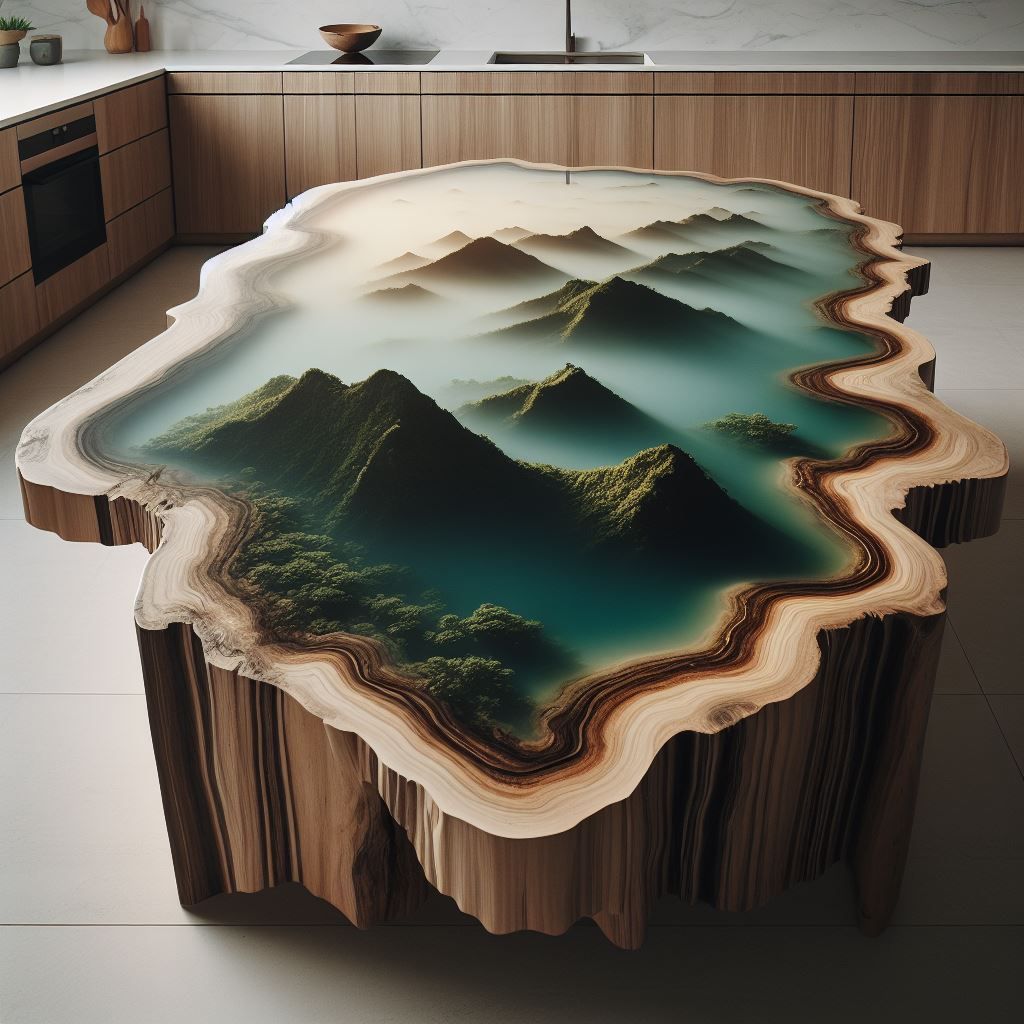
Eye-Catching Waterfall Effect
Extending the epoxy resin down the sides of your kitchen island can produce a mesmerizing waterfall effect that elevates its aesthetics. Picture translucent waves cascading along the edges, resembling flowing water frozen in time, adding movement and depth to the structure. This technique creates a seamless transition from wood to resin, giving off a contemporary vibe while maintaining an organic touch.
The waterfall effect is more than just visually striking; it also imparts sophistication and artistry to your wood epoxy kitchen island design. By allowing the epoxy resin to flow gracefully downwards like a waterfall on all sides of the island’s surface, you achieve a cohesive and fluid appearance that exudes elegance and style effortlessly.
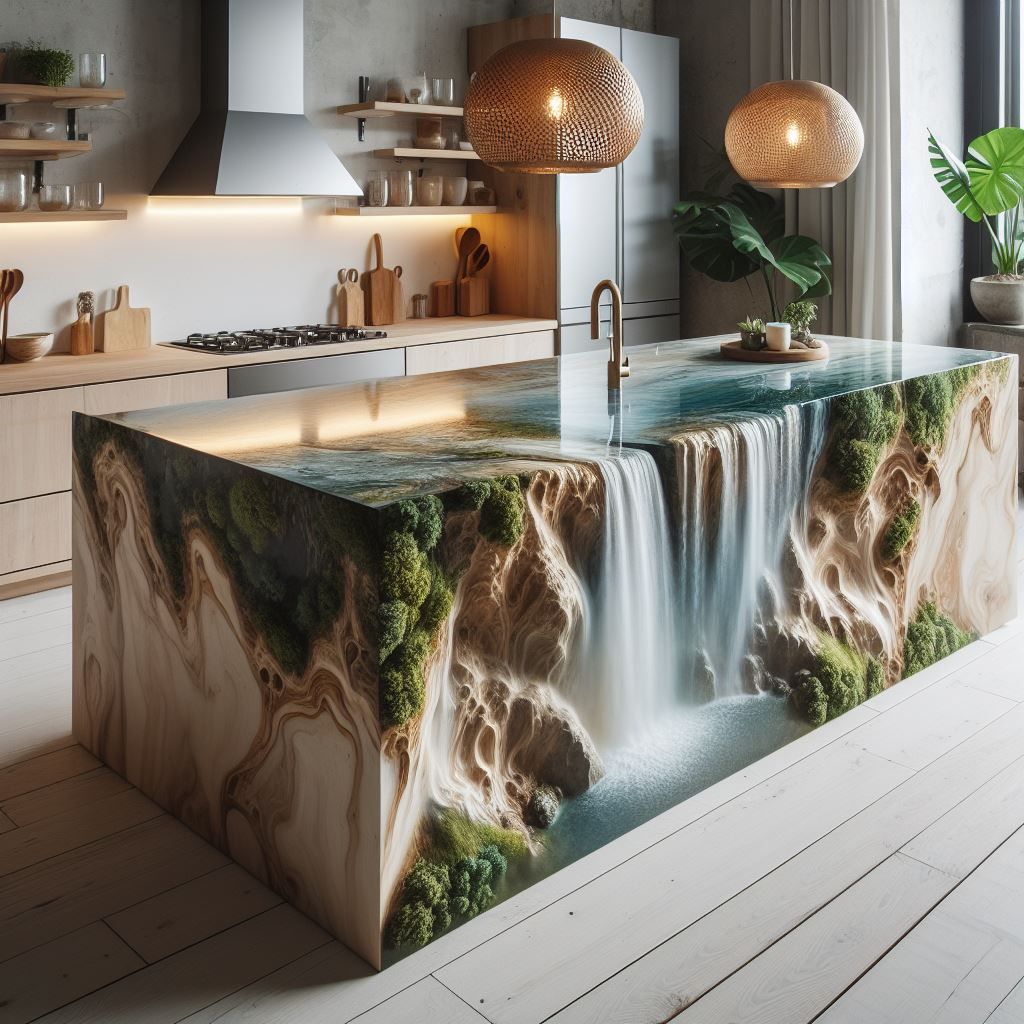
Captivating Designs Through Contrast
Combining different types of wood or utilizing contrasting colors in epoxy resin opens up endless possibilities for creating captivating designs on your kitchen island. Imagine blending dark walnut with light oak or infusing vibrant pigments into clear resin – these contrasting elements result in dynamic patterns and color interplays that make your island truly one-of-a-kind.
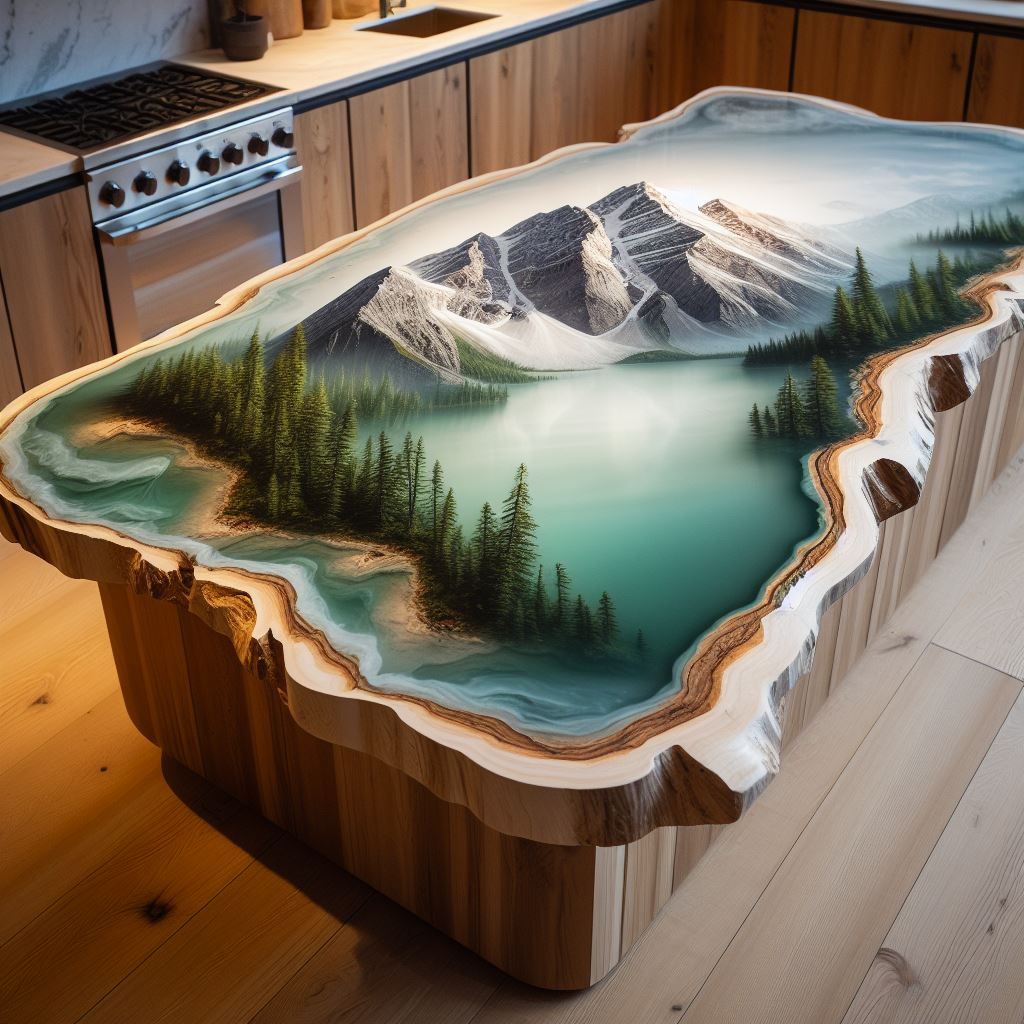
Summary
You’ve learned about the magic of combining wood and epoxy to create stunning kitchen islands that blend nature with contemporary design. From selecting materials to pouring resin and finishing touches, you now have the know-how to embark on your own creative journey. Remember, safety is paramount, and proper ventilation is key during the crafting process. Ensuring durability and aesthetic appeal will guarantee a masterpiece that stands the test of time. Let your imagination run wild as you explore unique ideas for your wood and epoxy kitchen island. Get ready to unleash your creativity and transform your kitchen into a work of art!


